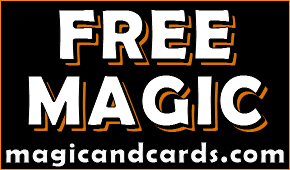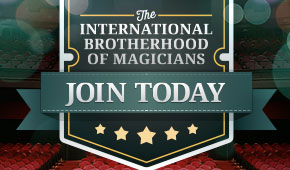The Linking Ring History - Part II
When W.W. Durbin joined the International Brotherhood of Magicians in the fall of 1923, total membership numbered just over two hundred. Durbin was a valuable name to add to the ranks of the growing organization. Although not famous as a magician, he performed professionally before becoming a lawyer and later pursued a successful business career. He was also an influential politician and had worked with William Jennings Bryan to sway the Ohio Democrats to support the nomination of Woodrow Wilson for President.
Born William Warner Durbin on September 29, 1866, in Kenton, Ohio – a small town by the Scioto River – he was educated in public schools in his hometown before earning a law degree at National Law University in Washington, D.C. He worked for the Department of the Treasury for four years beginning in 1886 as he attended school at night. In 1890, he married Mary L. Danaher and moved back to Kenton to establish his law practice.
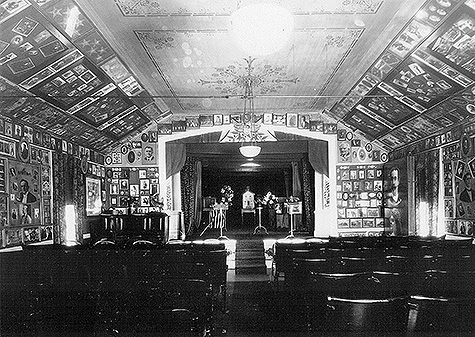 In 1895, Durbin constructed a small theater in his backyard, dubbing it “Egyptian Hall.” Seating one hundred fifty spectators, Durbin produced his own shows in the theater and encouraged visiting magicians to perform there as well. He covered the walls and ceiling with photographs and posters of magicians, eventually acquiring a collection of several thousand pieces.
In 1895, Durbin constructed a small theater in his backyard, dubbing it “Egyptian Hall.” Seating one hundred fifty spectators, Durbin produced his own shows in the theater and encouraged visiting magicians to perform there as well. He covered the walls and ceiling with photographs and posters of magicians, eventually acquiring a collection of several thousand pieces.
After fourteen years in law, Durbin gave up his practice and contemplated taking a show on the road under the management of a lyceum bureau. In May 1902, he met with the manager of the Inter-State Lecture Bureau and demonstrated his skills. The man told him he was sorry he hadn’t seen Durbin earlier because he had just signed up Phil Hunter, the Buckeye Wizard, from Chillicothe, Ohio.
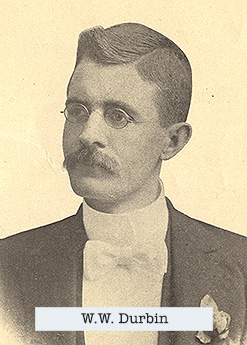
Meanwhile, a different kind of opportunity presented itself. A Kenton firm – the Scioto Sign Company, manufacturers of advertising signs made of steel, paper, wood, or cardboard – was on the brink of bankruptcy. They offered Durbin the job of manager and treasurer. He accepted and threw himself completely into the study of the manufacturing business. Durbin’s business acumen and leadership saved the company. He became co-owner and the business continued to prosper, eventually garnering profitable contracts for manufacturing license plates, which were advanced by his numerous political connections.
A natural organizer with a bent toward leadership, Durbin served on the local board of education and was chancellor commander for his lodge of the Knights of Pythias. In 1902, he joined the Elks and served as Exhalted Ruler for at least eight terms.
Durbin saw things in black and white; you were either for him or against him. Faced with opposition or a point of view he could not comprehend, his language could be blunt and salty. On other occasions, he was swept up in sentimentality and championed a fraternal spirit above all. In his office hung a plaque with a single word, reminding him of what was important in life: “OTHERS.”
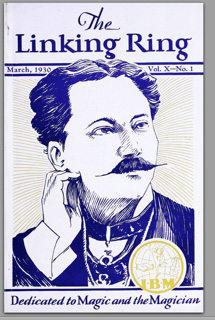 A practical, get-it-done businessman, Durbin had no patience with procrastinators. He lived by the motto, “Do it now!” and frequently exclaimed, “Don’t wait for George to do it!”
A practical, get-it-done businessman, Durbin had no patience with procrastinators. He lived by the motto, “Do it now!” and frequently exclaimed, “Don’t wait for George to do it!”
I.B.M. President and co-founder Len Vintus was also a person who believed in efficiency and action. He began corresponding with Durbin and found that he lived up to his reputation as an outgoing, friendly, enthusiastic supporter of magic. By 1925, Durbin made the cover of The Linking Ring and was lauded in an unsigned write-up as “America’s most popular non-professional magician,” having entertained the leading magicians at his home in Kenton, Ohio.
The article continued: “He is a strong booster for magic…and has taken a keen interest in the progress of the I.B.M. from the very start.” Durbin’s interest was so keen, in fact, that before Vintus knew what was happening, Durbin became president of the organization and then editor of The Linking Ring.
Though he was upset by the sudden turn of events, it was Vintus himself who enabled Durbin to so quickly displace him. Vintus had been charmed by Durbin, and when he offered the use of Egyptian Hall for a convention of I.B.M. members in 1926, Vintus happily accepted. As a gesture of goodwill, and against the advice of co-founder Gene Gordon, he placed Durbin on the ballot for president, not thinking that he, as co-founder, would be outvoted. An announcement was made in The Linking Ring, ballots were mailed, and votes were taken at the convention in Kenton that summer. Durbin soundly defeated Vintus two to one.
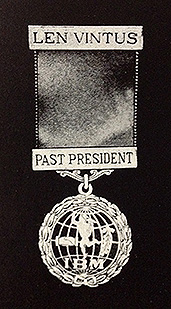 Durbin claimed he hadn’t wanted the job, but if magicians were set on having him as president, he would serve. To assuage Len Vintus’ hurt feelings, Durbin suggested making him Secretary of the I.B.M. – a position that hadn’t previously existed – and presented Vintus with a medal honoring him as the first Past President. He also proposed that Vintus should serve as editor of The Linking Ring. Ernie Schieldge, I.B.M. number three, had been editing the magazine, but issues appeared sporadically – so perhaps he was glad to turn the responsibility over to Vintus. In any event, following Durbin’s election, Schieldge was listed as Assistant Secretary, Gene Gordon as Publicity Director, and Len Vintus as Secretary, Editor, and Publisher of The Linking Ring.
Durbin claimed he hadn’t wanted the job, but if magicians were set on having him as president, he would serve. To assuage Len Vintus’ hurt feelings, Durbin suggested making him Secretary of the I.B.M. – a position that hadn’t previously existed – and presented Vintus with a medal honoring him as the first Past President. He also proposed that Vintus should serve as editor of The Linking Ring. Ernie Schieldge, I.B.M. number three, had been editing the magazine, but issues appeared sporadically – so perhaps he was glad to turn the responsibility over to Vintus. In any event, following Durbin’s election, Schieldge was listed as Assistant Secretary, Gene Gordon as Publicity Director, and Len Vintus as Secretary, Editor, and Publisher of The Linking Ring.
The fledging organization had moved The Linking Ring from an inexpensive mimeographed format to a more expensive printed edition in 1925, and Vintus, Gordon, and Schieldge were barely keeping their heads above water. Durbin, prosperous and more experienced, came to the rescue and began financing the magazine and selling ads.
As Durbin examined Vintus’ cost of producing The Linking Ring in Canada, he realized that it could be printed in the States for half of the amount. Durbin proposed that he handle the printing, and a dispute ensued – with Vintus at a clear disadvantage. Durbin had provided the location for the I.B.M. Convention, and the Great Blackstone had proposed a return to Kenton for 1927, which was enthusiastically approved by the membership. Furthermore, without Durbin’s continuing financial support of The Linking Ring, the burden would return to the founders. Vintus suddenly resigned in the spring of 1927, leaving Durbin to complete the May issue.
“Almost at the moment of going to press,” Durbin wrote, “the editing of the Linking Ring was thrown into new management by the resignation of Mr. Len Vintus, former editor. Therefore this number is rather a chaotic assembly of material, of arrangement and rearrangement."
The lateness of the change allows no time for comment, except the following:
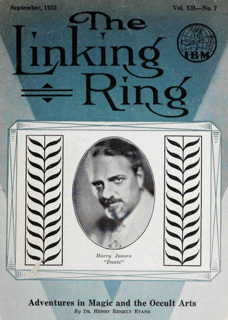 “We to whom has fallen the editorial duties of the Linking Ring salute you. We hope to make this magazine a fitting exponent of our great international Brotherhoood.” Durbin encouraged members to contribute ideas and to work together for the success of The Linking Ring. “This is the magazine of the I.B.M.,” he continued, “and should have as many reflections as a kaleidoscope, with the same orderly beautiful arrangement. Help us make it so.”
“We to whom has fallen the editorial duties of the Linking Ring salute you. We hope to make this magazine a fitting exponent of our great international Brotherhoood.” Durbin encouraged members to contribute ideas and to work together for the success of The Linking Ring. “This is the magazine of the I.B.M.,” he continued, “and should have as many reflections as a kaleidoscope, with the same orderly beautiful arrangement. Help us make it so.”
Durbin’s scuffle with Vintus did not drive away Ernie Schieldge, who was now listed as Secretary with Leslie P. Guest as Assistant Secretary. The masthead listed W. W. Durbin as Editor and Advertising Manager, with Ernest K. Schieldge as Associate Editor. Another Associate Editor was Eliza W. Durbin – Durbin’s unmarried sister who taught school and had the time and skills to help her brother edit the magazine.
The next month, June 1927, Durbin redoubled his efforts to promote the I.B.M. and expand membership. He urged: “Remember our slogan ‘2,500 members in June 1928, and 1,000 members present at the next convention.’ Pass the word along the line. Send us in a new member. Keep the ball rolling.”
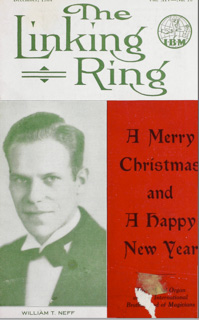
The name of John Braun – a future Executive Editor of The Linking Ring – first appears on the magazine’s masthead in this issue. Braun is listed as a member of the Exposé Committee, along with T. Nelson Downs, T. J. Crawford, and several others. Another change in the June issue was that, for the first time since the magazine’s inception, neither Len Vintus nor Gene Gordon were listed.
Despite these losses, Durbin’s management and organizational skills were evident by the apparent ease with which he assumed editorship of the magazine. He employed a secretary who took dictation to handle the prolific correspondence he maintained with magicians throughout the world, and his articles in The Linking Ring projected a conversational style as if they were dictated, with casual phrases and run-on sentences.
More determined than ever to turn the I.B.M. into a successful, worldwide order of magicians, Durbin relentlessly urged readers to bring in new members. He also wrote a steady stream of letters to leading magicians, telling them of the exciting gains in membership and enlisting their help in promoting the organization.
His enthusiasm for the I.B.M. was authentic. Anyone could see that progress was being made. At the beginning of 1926, membership totaled about 600. With Durbin rousing the troops and conducting his tireless letter-writing campaigns, the rolls swelled to more than 1,900 by the fall of 1927, so Durbin’s goal of 2,500 members by June 1928 – as incredible as that may have seemed at first – was now clearly attainable.
![]()
.jpg) On September 16, 1927, Howard Thurston replied to one of Durbin’s letters. “I am delighted to know of the amazing progress of the I.B.M.,” he wrote. “The I.B.M. is doing a wonderful work for magic and magicians. It is stimulating interest in the amateur and creating new recruits to the art. Its splendid management and forging ahead and obtaining so many new members is astonishing in itself….I congratulate you and the I.B.M. on the work you are doing, and [am] proud to be numbered among your workers.”
On September 16, 1927, Howard Thurston replied to one of Durbin’s letters. “I am delighted to know of the amazing progress of the I.B.M.,” he wrote. “The I.B.M. is doing a wonderful work for magic and magicians. It is stimulating interest in the amateur and creating new recruits to the art. Its splendid management and forging ahead and obtaining so many new members is astonishing in itself….I congratulate you and the I.B.M. on the work you are doing, and [am] proud to be numbered among your workers.”
Harry Blackstone also responded to a letter from Durbin on October 2: “Words can not express how pleased I am to know that our membership in the I.B.M. is over nineteen (19) hundred, greater now than all other Magic societies combined."
“An organization with so many wonderful people, certainly puts the Art of Magic away up where it belongs. One of the first questions I am asked today when entering a newspaper office is, ‘Do you belong to the I.B.M.?’, and how proud I am to say that I am the first Vice President and that W. W. Durbin is our president, for it is your persistent efforts that has caused the I.B.M. to forge ahead with leaps and bounds….May the I.B.M. membership list grow to ten thousand, so that a still greater interest will be had. Long live the I.B.M.!”
At the 1928 convention, Durbin’s lofty membership goal was surpassed as the 2,520th member joined. Always giving credit to the OTHERS of whom he was reminded by his plaque, Durbin wrote in the June 1928 issue: “You are to be congratulated upon the splendid showing we have made in the past year.”
From a business standpoint, improvements in the organization were obvious. With Len Vintus at the helm, the financials for June 1927 reflected a cash balance of $97.40. After a year of Durbin’s management, ad sales swelled, membership increased, costs were reduced, and the June 1, 1928 financial report showed a cash balance of $3,379.67.
“We need not worry about the future of the I.B.M.,” Durbin wrote. “Was there ever a more enthusiastic bunch of fellows?” What Durbin couldn’t predict, however, was the dramatic financial collapse soon to come and the onset of something no one expected – the Great Depression.
---------------------------



